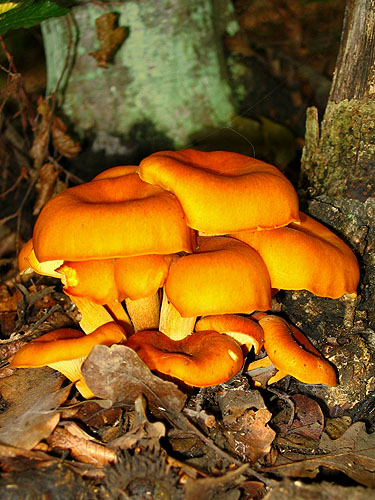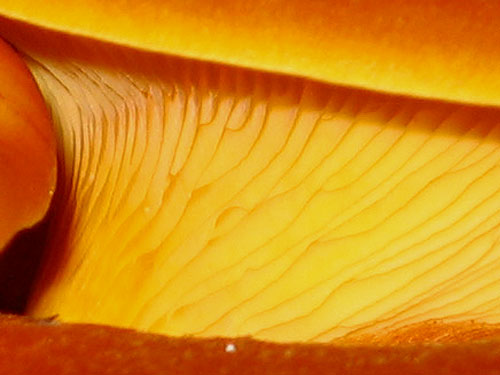Omphalotus Fayod
Fruitbodies clustered on roots of deciduous trees. Cap depressed to funnel-shaped, usually orange coloured. Gills strongly decurrent, forking. The representatives of this genus are best known for their bioluminiscent properties, i. e. their ability to glow in the dark, which is due to the oxidation of a compound, called luciferin.Two species are so far known in Europe.
Omphalotus olearius (DC. : Fr.) Fayod
Description
Cap up to 10 cm, depressed to funnel-shaped, orange to vivid orange, sometimes spotted coppery or brownish, sometimes in very old fruibodies entirely brown; cap margin often splitting. Stipe usually tapering towards the base, concolorous. Flesh yellow, unchanging when exposed to air. Gills orange, strongly deccurrent (running down the stipe). Smell not distinctive. Taste not distinctive. Spores 5–6 × 4.5–5 μm.
Habitat. In broadleaf and mixed forests, tufted on stumps of deciduous trees, most often oaks (Quercus) or beech (Fagus).
Distribution. Widespread in Europe, but likely more southern species.
Photographs

Well developed fruitbodies of Omphalotus olearius. (photo B. Assyov)

Fruitbodies of Omphalotus olearius. (photo B. Assyov)

Fruitbodies of Omphalotus olearius. Note the coppery red colour. (photo I. Assyova)

Omphalotus olearius - detail of the forking gills. (photo B. Assyov)
Important literature
Breitenbach J. & Kränzlin F. 1991. Pilze der Schweiz. Bd. 3(1). Röhrlinge und Blätterpilze. Verlag Mykologia, Luzern.
Kirchmair, M. & Pöder, R. 2002. Why Omphalotus illudens (Schwein.) Bresinsky & Besl is an independent species. – Revista Catalana de Micologia 24: 215–223. (available online)
Kirchmair, M., Morandell, S., Stolz, D. & Pöder, R. 2004. Phylogeny of the genus Omphalotus based on nuclear ribosomal DNA-sequences. – Mycologia 96: 1253–1260. (available online)